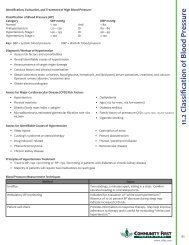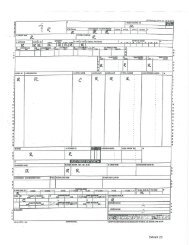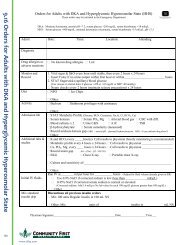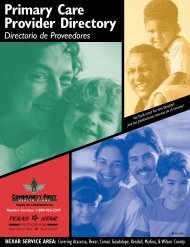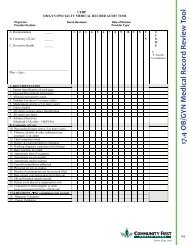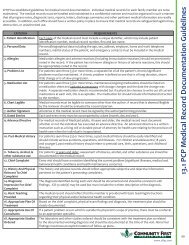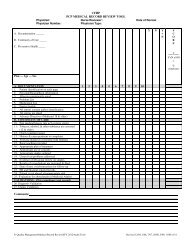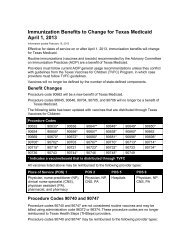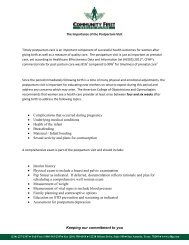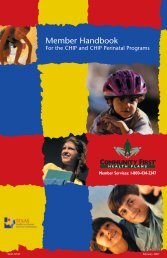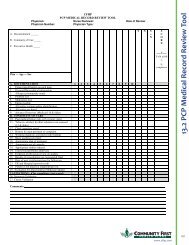Full Clinical Guidelines - Community First Health Plans.
Full Clinical Guidelines - Community First Health Plans.
Full Clinical Guidelines - Community First Health Plans.
Create successful ePaper yourself
Turn your PDF publications into a flip-book with our unique Google optimized e-Paper software.
AMERICAN ACADEMY OF PEDIATRICS:<br />
Failure to Thrive as a Manifestation of Child Neglect<br />
Robert W. Block, MD, Nancy F. Krebs, MD and the Committee on Child Abuse and Neglect and the Committee on Nutrition<br />
PEDIATRICS Vol. 116 No. 5 November 2005, pp. 1234-1237 (doi:10.1542/peds.2005-2032)<br />
Recognition of Failure to Thrive (FTT) Secondary To Neglect or Abuse<br />
The risk factors that should alert the pediatrician to the possibility of neglect as the cause of FTT include:<br />
• parental depression, stress, marital strife, divorce;<br />
• parental history of abuse as a child;<br />
• mental retardation and psychological abnormalities in the parent(s);<br />
• young and single mothers without social supports;<br />
• domestic violence;<br />
• alcohol or other substance abuse;<br />
• previous child abuse in the family;<br />
• social isolation and/or poverty;<br />
• parents with inadequate adaptive and social skills;<br />
• parents who are overly focused on career and/or activities away from home;<br />
• failure to adhere to medical regimens;<br />
• lack of knowledge of normal growth and development; and/or<br />
• infant with low birth weight or prolonged hospitalization.<br />
Guidance for the Pediatrician<br />
1. Pediatricians are encouraged to recognize that child neglect is among the many causes of FTT.<br />
2. Pediatricians are strongly encouraged to consider child abuse and neglect and to report cases of FTT that do not resolve<br />
with appropriate interventions.<br />
AMERICAN ACADEMY OF PEDIATRICS:<br />
Investigation and Review of Unexpected Infant and Child Deaths<br />
Committee on Child Abuse and Neglect and Committee on <strong>Community</strong> <strong>Health</strong> Services<br />
PEDIATRICS Vol. 104 No. 5 November 1999, pp. 1158-1160<br />
The American Academy of Pediatrics recommends that:<br />
1. Pediatricians advocate for proper death certification for children. Such certification is not possible in sudden unexpected<br />
deaths in the absence of a comprehensive death investigation, including scene investigation, autopsy, and review of<br />
previous medical records.<br />
2. Individual pediatricians and those working through AAP chapters support state legislation that requires autopsies of<br />
all deaths of children younger than 18 years that result from trauma; that are unexpected, including SIDS; and that are<br />
suspicious, obscure, or otherwise unexplained. These same guidelines about unexplained deaths should apply to all<br />
children, even those with chronic diseases.<br />
3. Individual pediatricians and those working through AAP chapters advocate for and support state legislation and other<br />
efforts that establish comprehensive child death investigation and review systems at the local and state levels.<br />
4. Pediatricians accept the responsibility to be involved with the death review process, including serving as a member of a<br />
review team, providing information from case files to the medical examiner or other agency investigating the death of a<br />
child who was a patient, or by serving as a consultant to the child fatality team on medical issues that need clarification.<br />
5. Pediatricians assist local public health, medical society, and other interested groups to become involved with the child<br />
death review process.<br />
6. Pediatricians become involved in the training of death scene investigators so that appropriate knowledge of issues such as<br />
SIDS, child abuse, child development, and pediatric disease is used in the determination of the cause of death.<br />
7. Public policy initiatives directed at preventing childhood deaths, based on information acquired at the local and state levels<br />
from adequate death investigations, accurate death certifications, and systematic death reviews, be supported at the<br />
national and chapter level.<br />
8. The following recommendations pertaining to the investigation and review of child deaths, published by the US Advisory<br />
Board on Child Abuse and Neglect should be supported.<br />
• “The supply of professionals qualified to identify and investigate child abuse and neglect fatalities should be increased.”<br />
• “There must be a major enhancement of joint training by government agencies and professional organizations on the<br />
identification and investigation of serious and fatal child abuse and neglect.”<br />
• “States, military branches, and Indian Nations should implement joint criminal investigation teams in cases of fatal child<br />
abuse and neglect.”<br />
8.2 AAP Policy Recommendations<br />
H EALTH PLANS<br />
www.cfhp.com<br />
39



